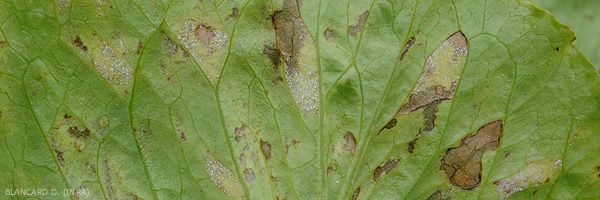
FBremia lactucae Regel (1843)
FMildew
- classification : Chromista*, Oomycota, Oomycetes, Peronosporomycetidae, Peronosporales, Peronosporaceae
- English name: Downy mildew ; Spanish name: mildiù of lechuga
- English name: Downy mildew ; Spanish name: mildiù of lechuga
Bremia lactucae is an oomycete which parasitizes around 230 plants belonging to the asteraceae family (ancient compounds). In fact, there are many specialized forms suitable for a more or less extensive host range.
The mildew or "sucker" is one of the oldest diseases, the most common and most deadly, affecting lettuce grown in the field as well as indoors. It is particularly prevalent in production areas which experience prolonged periods of humidity (rains, sprinkler irrigation, fog, dew, etc.) and cool weather, particularly in Europe. It can be responsible for considerable losses and devastate entire crops in a few days, if the climatic conditions are very favorable to it. Bremia lactucae, which mainly affects lettuce, has been reported in the vast majority of salad producing countries; it is often a constant threat and requires preventive fungicide treatments.
Whatever the production areas, the control of mildew is not easy, for two reasons in particular:
- many physiological breeds , capable of bypassing the majority of resistance genes introduced into varieties of lettuce, have been listed in several countries, making the genetic control implemented locally and temporarily obsolete;
- strains resistant to certain fungicides belonging to the phenilamide family (metalaxyl, oxadyxil, etc.) have been described, calling into question their use.
In France , a country with a temperate climate par excellence, Bremia lactucae is very common and feared by all lettuce producers, especially during winter production periods. The latter implement very early, from the nursery, a set of control methods to control it as well as possible.
* There are about 800 saprophitic or parasitic species of Oomycetes. The latter have long been classified in the Phycomycetes or "lower fungi" (Eumycetes). This classification was questioned a few years ago because their ultra structure, their biochemistry and their molecular sequences indicated that they belonged to the Chromists, including especially algae (green and brown), diatoms. Currently, according to bibliographic sources, these "water molds" are associated with the reign of Chromista ( Index fungorum ) or Stramenopila ( Tree of life ).





